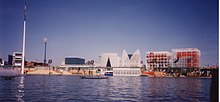Seville Expo '92
| EXPO Sevilla 1992 | |
|---|---|

Panorama of the pavilions on the Lago de España at Expo'92 Seville.
|
|
| Overview | |
| BIE-class | Universal exposition |
| Name | Exposición Universal de Sevilla 1992 |
| Motto | The era of discoveries |
| Area | 215 ha |
| Visitors | 41.800.000 |
| Participant(s) | |
| Countries | 112 |
| Location | |
| Country | Spain |
| City | Sevilla |
| Venue | Isla de la Cartuja |
| Coordinates | 37°24′30″N 6°0′1″W / 37.40833°N 6.00028°W |
| Timeline | |
| Bidding | March 3, 1982 |
| Awarded | December 8, 1982 |
| Opening | April 20, 1992 |
| Closure | October 12, 1992 |
| Universal expositions | |
| Previous | Expo '70 in Osaka |
| Next | Expo 2000 in Hanover |
| Specialized expositions | |
| Previous | Expo 91 in Plovdiv |
| Next | Taejon Expo '93 in Taejon |
| Horticultural expositions | |
| Previous | Expo '90 in Osaka |
| Next | 1993 World Horticultural Exposition in Stuttgart |
| Simultaneous | |
| Specialized | Genoa Expo '92 |
| Horticultural (AIPH) | Floriade 1992 |
| Internet | |
| Website | Web de Expo´92 |
The Universal Exposition of Seville (Expo '92) took place from Monday, April 20 to Monday, October 12, 1992 on La Isla de La Cartuja (Cartuja Island), Seville, Spain. The theme for the Expo was "The Age of Discovery" and over 100 countries were represented. The total amount of land used for the Expo was 215 hectares and the total number of visitors was 41,814,571 (as per the BIE website [1]). Although not related, the exposition ran at the same time as the smaller Genoa Expo '92.
Expo'92 was organized to celebrate the 500th anniversary of the discovery of the Americas by Christopher Columbus (1492-1992). The exposition was to be jointly held with the City of Chicago, however, due to national, state, and local funding difficulties, Chicago did not accept the offer.
Expo'92 Seville was widely known for its massive site, held at the Isla de la Cartuja, reputed site of reference for Columbus for his voyage to the New World, and required at least several days to visit most of the Pavilions. It was also known for its numerous spectacular gates and bridges, and the diversity of transport within the Expo site from bus to ferry boat, to cable car and monorail. It also gave an impressive architectural tour of the world, with many countries vying for the position of the most inventive or creative Pavilion structure - outstanding amongst these was the Pavilion of Japan - the world's largest wooden structure, the Pavilion of Morocco, a re-creation of a Moroccan Palace-Mansion, and the modernistic cube and sphere of the flagship Spanish Pavilion, to name a few. The most popular pavilions with visitors were those of Spain and Canada.
Pavilions at the Expo consisted of the Royal Pavilion and the five thematic Pavilions - Navigation, Discovery, Nature, Environment, and the Fifteenth Century; the flagship Spanish and Andalusian Pavilions at the Lake of Spain; the Spanish Autonomous Regions Pavilions all along the Lake of Spain; over 100 international Pavilions; and numerous Corporate Pavilions.
In particular the Discoveries Pavilion featured an Omnimax Theatre, where a Spanish government commissioned theme film, Eureka!, made by Greg MacGillivray and Jon Boorstin, based on The Discoverers, by Daniel J. Boorstin was presented. The first IMAX film to use a light-weight hand held camera (with a steadicam), it won the principal creative award at the fair.
...
Wikipedia
